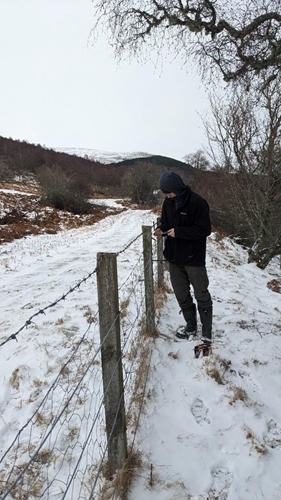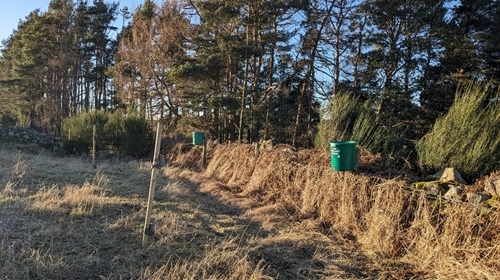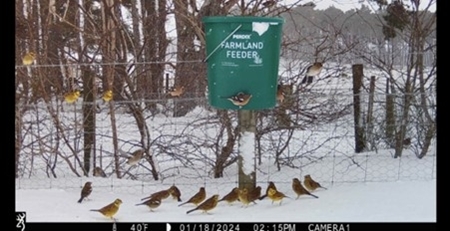By Kate Goodman, Scottish Demonstration Farm Placement Student
 Songbird feeders come in many shapes and sizes and are a common sight in gardens, filled with hundreds of different seed and grain mixes to suit a variety of birds and beak sizes. Yet despite the options available, the reality is overwinter feeding options for songbirds in farmland settings remain somewhat limited. So that is something we are aiming to change with our new songbird feeder research in Scotland.
Songbird feeders come in many shapes and sizes and are a common sight in gardens, filled with hundreds of different seed and grain mixes to suit a variety of birds and beak sizes. Yet despite the options available, the reality is overwinter feeding options for songbirds in farmland settings remain somewhat limited. So that is something we are aiming to change with our new songbird feeder research in Scotland.
Currently, the Agri-Environment Climate Scheme (AECS) in Scotland doesn’t have any options for providing food to farmland birds using songbird feeders – shocking, we know! Payments are only available when seed-bearing crops are sown, or habitat is created to benefit farmland ground-feeding birds, which potentially excludes a number of songbirds that often struggle during the cold months during a period called the ‘hungry gap’. This is a period where the lack of food availability and colder temperatures can lead to declines in health and even death.
Although the current provisions for supplementary feeding of farmland birds over winter are effective and beneficial to birds, they take time to establish and require a portion of land, whereas the farmland bird feeders we’re using only require hungry visitors and a sturdy fencepost. Therefore, given the importance of supporting our declining songbird populations, and following on from the success in overwinter supplementary feeding demonstrated by the Allerton Project, we decided to trial it at Auchnerran too. In 2022 we began by looking into whether birds visiting songbirds visiting 16 feeders at eight sites across Auchnerran showed any preference between two seed mixes (as explained in the blog by Adam Watts here). What we found was that there was seemingly no difference in songbird diversity using either of the seed types, and so we decided to dig a little deeper.
So yes, we’re scientists; of course we’ve changed the methodology accordingly. The aim of the project this year is similar to that of 2022 as we are again investigating a comparison between two different seed mixes. However, this year we have used a classic wild bird seed mix, and a simplified bespoke mix, which we refer to as the enhanced game bird mix (or EHG), which is substantially more affordable. Although this may not seem like a viable reason for choosing a seed mix for a research project, we want this research to be applicable to farmers. Wheat makes up the bulk of the mix (~60%), with the remaining made up of oilseed rape and white millet (small seeds to account for birds with smaller beaks) and black sunflower seeds, which are more appealing for our finches with larger beaks. It also gives us scope to look at whether the increased nutritional availability is important, and enough variety to account for a preference between the seed mixes.
 Feeders up and running!
Feeders up and running!
In comparing the two different mixes, we are aiming to test whether there is a significant difference in either the diversity of species using each type, or the overall usage. This is because supplementary feeding is not intended to fulfil all the birds’ nutritional needs but just to supply enough food to bridge the ‘hungry gap’. Therefore, there may be little need to invest in an expensive and diverse wild bird seed mix, if you can achieve a similar result with a much-simplified mix of a few key items.
To make this research as widely applicable to Scottish farming systems as possible, we have a total of 19 different sites, centring around Auchnerran in Aberdeenshire and Balgonie in Fife. All are located on farmland near to hedgerows or boundary vegetation for cover and encompass a variety of different livestock-based and arable farming systems. At each site we have a pair of feeders roughly 5m apart (one with each seed type), and two cameras per feeder, one to gather data on the birds using the seed mixes, and one to assess the potential impact of non-target species like rodents. In each pair we swap the feeders each week, which means we can account for tiny variations in the microhabitat that may be affecting the birds’ choice of which feeder to visit. For example, if one feeder was marginally closer to a hedgerow or boundary vegetation it may be more appealing if there’s cover and safety for smaller birds closer by.
 How many yellowhammers can you see?
How many yellowhammers can you see?
Another detail we have carefully considered is our bird health and safety (no safety videos included), including disease risk. Finch trichomonosis is one such nasty disease that can be spread at bird feeders and bird baths if they’re not kept clean and hygienic. ‘Trich’, as its often known, can affect a variety of birds and sadly has caused dramatic declines in chaffinch and greenfinch populations across the UK. Therefore, we have set out stringent precautions to prevent the spread, including disinfecting feeder ports every time they are visited. Thankfully, throughout the entire period we have had the feeders active, we have recorded no sign of disease at any of the sites either when we have visited or via the trail camera data. But PSA, folks: clean your feeders regularly!
So far, early signs have been extremely positive, and we have recorded a huge variety of species visiting both the EHG and wild bird seed mix. Including (but not limited to): very large numbers of chaffinch; great tits; coal tits; house sparrows; brambling; greenfinch; dunnocks; yellowhammers; and, most surprisingly, great spotted woodpeckers. This research will hopefully enable us to improve AECS options for our many threatened songbirds, but running a study at this scale is expensive! With your help we can continue our research and further dive into songbird feeder research next year. You can sponsor a songbird feeder below and help to give our little birdies the boost they need, with any and all donations enormously appreciated.
SPONSOR A SONGBIRD FEEDER >